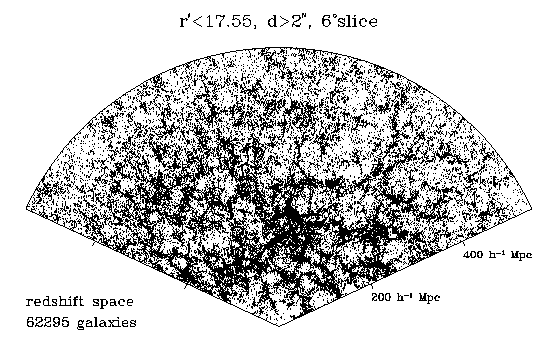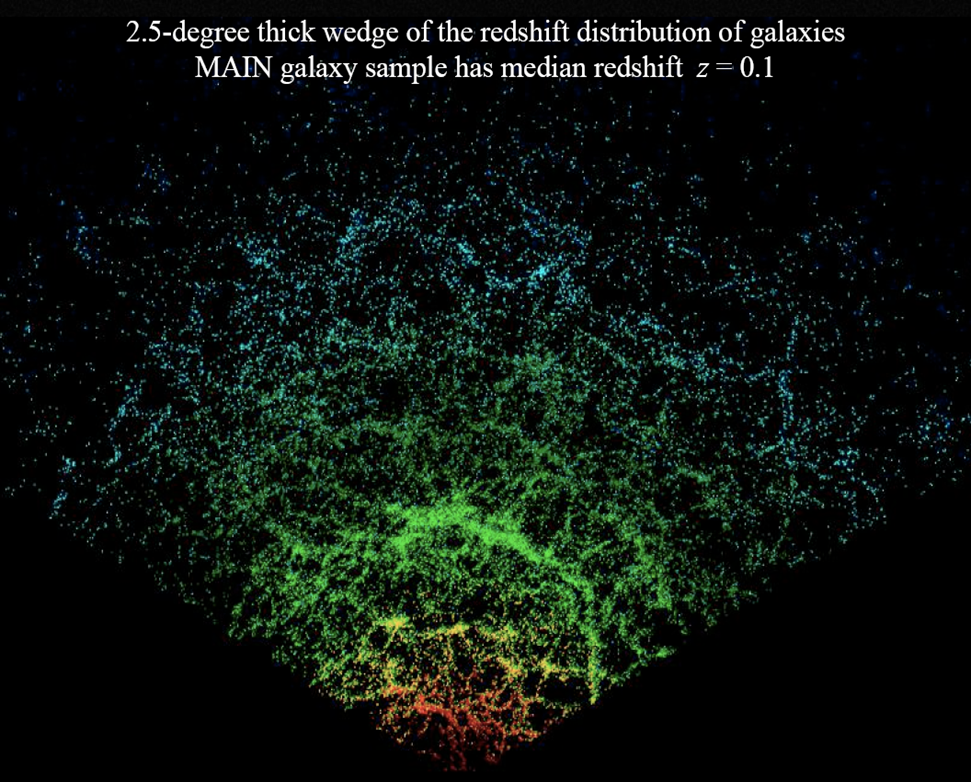

By measuring the redshift of a million galaxies, the Sloan Digital Sky Survey is creating a three-dimensional picture of our local neighborhood of the universe.
Large-Scale
Structure
The study of the large-scale structure of
the universe is also
undergoing a tremendous growth. In the early 1980's there were less
than 5,000 galaxy redshifts known. However, we now have over 50,000 and
will soon have more than 1,000,000. Several new surveys such as
2-Degree Field (2dF) Survey and Sloan Digital Sky Survey (SDSS) have
recently been completed. Within a few years the 3-dimension al
distribution of galaxies in our local universe will be mapped.
Furthermore, those structures can be matched to the early time snapshot
of density perturbation (temperature fluctuations in CMBR). Since any
model of structure formation must explain both the temperature
fluctuations in CMBR and the large-scale structures we observe today in
the universe, the combination of these two probes is especially
powerful.
|
|
A large N-body simulation run by Changbom Park and Richard Gott. The simulation uses Park's (1990) particle-mesh, N-body code to evolve 380³ ~ 55 million particles on a 600³ mesh that represents a comoving, periodic cube 600 h-1 Mpc on a side. The background cosmological model is a flat universe with Omega0=0.4, a cosmological constant La large N-body simulation run by Changbom Park and Richard Gott. The simulation uses Park's (1990) particle-mesh, N-body code to evolve 380³ ~ 55 million particles on a 600³ mesh that represents a comoving, periodic cube 600 h-1 Mpc on a side. The background cosmological model is a flat universe with Omega0=0.4, a cosmological constant Lambda0=0.6 , and a Hubble constant h=0.6 . The initial conditions are Gaussian fluctuations with a cold dark matter (CDM) power spectrum corresponding to these values of Omega0 and h . ambda0=0.6 , and a Hubble constant h=0.6 . The initial conditions are Gaussian fluctuations with a cold dark matter (CDM) power spectrum corresponding to these values of Omega0 and h . |
|
|
By measuring the redshift of a million galaxies, the Sloan Digital Sky Survey is creating a three-dimensional picture of our local neighborhood of the universe. |
[Koean]
우주 거대구조의 기원
우주에는 은하단, 초은하단, 거대공동(void) 등과 같이 수 많은 은하들로 이루어져 있고, 크기가 수십 수백만 광년에 이르는 우주거대구조가 있다. 이들은 우주 초기의 급팽창 시기에 발생한 미약한 밀도 요동이 137억년 동안 중력 진화를 겪으면서 생겨난 것이다. 고등과학원의 천체물리 그룹은 86억 개의 입자들을 진화시켜 세계 최대 규모의 우주거대구조 시뮬레이션을 수행하였다. 이 시뮬레이션 자료는 대규모 우주 탐사 국제 프로젝트인 SDSS (Sloan Digital Sky Survey)의 실제 관측 자료와 여러 우주 모형의 예측을 서로 비교함으로써 우주모형을 개선하고, 우주 거대구조의 기원과 진화를 이해하는 데에 사용되고 있다. 우주거대구조 시뮬레이션에서 필라멘트 형태로 늘어선 은하 헤일로들(여러 색으로 구별함)의 모습. 시뮬레이션 자료는 은하들의 특이 속도장, 은하의 3차원 모양과 주변 조석력의 관계, 밀도요동의 토폴로지(topology) 등을 알아내어 우리 우주의 물리적 특성을 연구하는 데에 사용된다.
 |
|